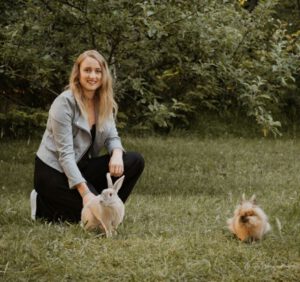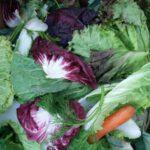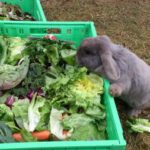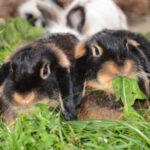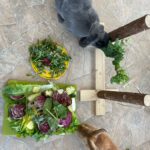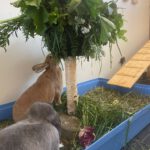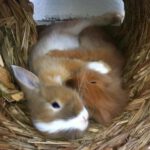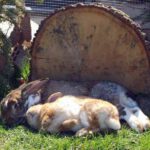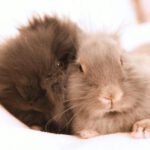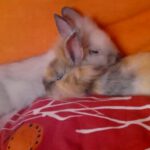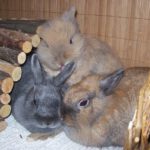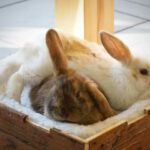Hairballs, constipation, obstruction, foreign objects
Attention: Refusal to eat in rabbits is always an emergency and life-threatening! Veterinary emergency services should be consulted immediately!
Constipation can initially be recognized by the rabbit passing less or no poops. Similarly, no poops will be passed if the rabbit isn’t eating due to another illness!
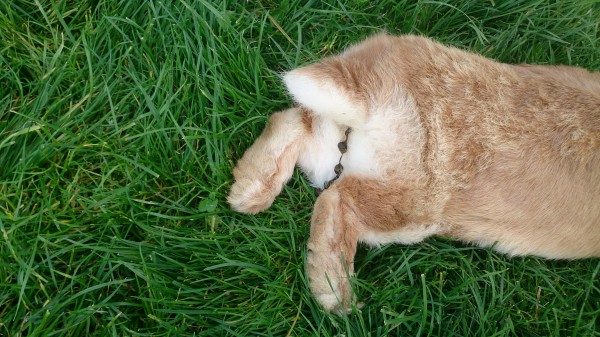
Contents
Causes
- The most common causes include the ingestion of (clumping) cat litter, straw pellets, food pellets, cardboard, fabrics, carpets, vetbeds/isobeds, carob seeds, or other items that swell or clump significantly in the stomach and intestines (e.g., foreign objects like plastic).
- Often, constipation is also caused by the ingestion of large amounts of fur (through grooming their own fur, grooming the fur of other rabbits during molting, or compulsively pulling out their own fur). This fur can form a solid mass in the intestines (bezoar, hairball). However, hairballs usually only cause problems if the rabbits are not fed exclusively with fresh food but are given some type of dry food, oats, etc., or if fresh greens are not available 24 hours a day, forcing the rabbits to consume excessive amounts of hay.
- Constipation can be significantly exacerbated or even caused by feeding a rabbit a very dry, energy-dense, or protein-rich diet. The dry food mass cannot be moistened properly, preventing it from moving through the digestive tract. A rabbit’s natural diet consists of 70-80% moisture (fresh food), so their digestion is designed for a very moist food passage.
- Parasite infestations, such as coccidia, less commonly yeast infections, or worms, can also cause constipation. Submit a three-day stool sample to rule out parasites.
- Lack of access to drinking water can lead to constipation.
- Infectious diseases and space-occupying diseases of the uterus or other organs can be contributing factors.
- Lack of movement, restricted living space, and/or obesity can worsen constipation.
- A fiber-poor, dry, or poorly digestible diet generally intensifies constipation in rabbits.
Additionally, sudden large amounts of dry food or treats often lead to constipation.
A thyroid underfunction (hypothyroidism) can also trigger constipation.

Treatment and Care
Make sure to visit a veterinarian who is not only specialized in small animals (dogs and cats) but also in exotic pets (rabbits and rodents)!
Only veterinarians with targeted training can treat rabbits, as they are only a minor focus during general veterinary studies.Finding a Veterinarian:
Since this is a life-threatening emergency, you may need to visit a veterinarian even if a rabbit-specialized vet is not available at the moment.
If no poops are passed at all and the rabbit stops eating, an immediate visit to the veterinarian is required. If constipation persists, it can become life-threatening. X-rays at the vet are essential to determine the cause.
For more information on first aid and treatment, you can read here: Gastric Dilatation.
Under no circumstances should supplementary feeding, force-feeding, or syringe feeding be done! The digestive tract is already completely overloaded, and additional food intake in such a massive form only exacerbates the problem and can lead to death.
Surgery as Treatment:
If the hairball still causes severe problems and treatment is not successful, surgery may be performed. However, the stomach or intestines should not be opened, as many animals die in the days following such an operation. Instead, the hairball can almost always be manually pushed or massaged into the large intestine after opening the abdominal wall. Alternatively, the hairball can be massaged back into the stomach and then broken down through kneading.
For more information about the surgery, you can read here: Gastric Dilatation.
Diet During Shedding (to Prevent Hairballs)
To prevent life-threatening hairballs (hair clumps in the digestive tract), it is important to proactively comb out loose fur, especially during shedding periods. You can remove loose fur by either brushing or regularly stroking with your hands or damp rubber gloves. Plucking brushes are ideal for removing excess fur. To help less tame rabbits shed their fur, you can equip tight spots, burrows, or tunnels in their enclosure with brushes, so the rabbits groom themselves while passing through.
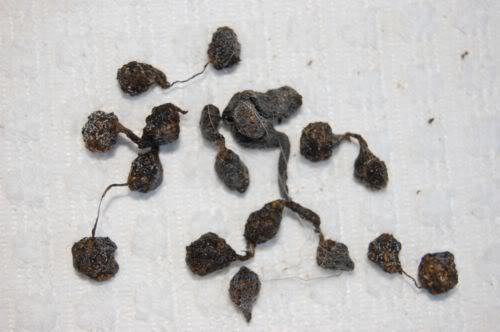
A supportive diet can help prevent hairball formation. Feeding a large amount of meadow plants or offering herbs and leafy vegetables in unlimited amounts is ideal. Fresh greens should be available at all times, day and night, as this is the best way to prevent hairballs! Dry food (including dried herbs, hay, etc.) can contribute to hairball formation!
Supporting with oil seeds (especially flaxseeds and sunflower seeds) is also beneficial. A half-teaspoon per rabbit per day should not be exceeded. Flax seeds, chia seeds, and psyllium seeds must be soaked beforehand. These seeds also strengthen the fur, resulting in a healthy, shiny coat. Even better are flax cakes, flax pellets, etc. (never more than 1 pellet per day per rabbit!). They also help with hair removal. Alternatively, a small amount of cooking oil can be mixed with food, for example, hidden in a banana. Coconut oil (up to 1 teaspoon per day per rabbit in extreme cases) can also be added to food. RodiCare Hairball has also proven effective.
Psyllium husks or flax seeds can be soaked in water overnight and mixed with tasty vegetables (grated) or fruits (grated) and offered to the rabbit (1 teaspoon (5g) in 100ml of water overnight; feed 1-3 teaspoons per rabbit mixed with grated carrot, and freeze the rest in ice cube trays to thaw as needed). This is a cost-effective alternative to RodiCare Hairball.
And very importantly, offer your rabbits plenty of space to move around both day and night to help them pass hairballs. In indoor and sheltered outdoor environments, extra cleaning (vacuuming) is necessary during shedding because the wind, which naturally removes the fur, is absent. In extreme cases, it may help to trim the fur of indoor rabbits, so the fur they ingest is much shorter.
Poop chains, by the way, are not a cause for concern; on the contrary, when poop chains appear, it means that the hair is being passed out of the body and not remaining in the intestines to form hairballs.
And once again, provide your rabbits with plenty of space to move around at all times. This helps relieve hairballs.
The following dietary and housing mistakes promote the formation of life-threatening hairballs:
- Hay as the main food with fresh food portions
- Hay as the main food with dry food & fresh food (dry food also absorbs all the moisture)
- Hay-based diet,
- Dry food-based diet, and
- Feeding methods with low fiber content: Too much concentrated food (seeds, grains, etc.), commercial dry food, etc. Dry food not only absorbs moisture but also has very little water content and fiber.
Malt Paste? Bezo-Pet Paste?
The composition of these pastes is largely flawed or not listed on the packaging. Usually, only the effects are described, which, according to the packaging, rely on three factors: plant oils and fats, fiber, and malt, which is supposed to aid digestion. Cat pastes are nearly identical to rabbit pastes and are often used by many pet owners. However, these pastes are only fiber-rich for cats. Any rabbit food (herbs, hay, branches) contains significantly more fiber than these pastes! Rabbits naturally consume far more fiber than cats do in a typical diet. What is considered fiber-rich for cats can be classified as fiber-poor for rabbits.
Malt (malt) consists of cereal sprouts that are dried and processed after a short germination period. Often, it is poorly digestible wheat. In addition, there are many additives that can harm rabbits. The only beneficial component is the plant oil, which can also be administered in a healthier form (pure or, for example, as „RodiCare akut“). The pastes do not contain any active ingredients that could help with hairballs. Instead, they contain many harmful substances, and most of the ingredients are not listed.
A better option is RodiCare Hairball, which is based on swollen psyllium seeds.
Sources:
Böhmer, E. (2005): Röntgenologische Untersuchung bei Hasenartigen und Nagern (Schwerpunkt: Magen-Darm-Trakt, Harntrakt, Wirbelsäule). Tierärztliche Praxis Ausgabe K: Kleintiere/Heimtiere, 33(02), 115-125.
Böttcher, A. (2017): Untersuchungen zur Magendilatation bei Heimtierkaninchen (Oryctolagus cuniculus) (Doctoral dissertation, Freie Universität Berlin).
Cheeke, P. R., Cunha, T. J. (2012): Rabbit feeding and nutrition. Elsevier.
Drescher B. (2014): Magenüberladung beim Kaninchen. Kleintier konkret 2: 12–16
Eckert, Y. (2020): Stillstand: Der Ileus beim Kaninchen. kleintier konkret, 23(S 01), 2-10.
Feldman, E. R., Singh, B., Mishkin, N. G., Lachenauer, E. R., Martin-Flores, M., & Daugherity, E. K. (2021): Effects of Cisapride, Buprenorphine, and Their Combination on Gastrointestinal Transit in New Zealand White Rabbits. Journal of the American Association for Laboratory Animal Science.
Harcourt-Brown, F. M. (2007): Gastric dilation and intestinal obstruction in 76 rabbits, Veterinary Record 161, 409-414
Harcourt-Brown (2007): Gastric dilation and intestinal obstruction in 76 rabbits. Vet Rec 161 (12): 409–414
Harcourt-Brown TR. (2007): Management of acute gastric dilation in rabbits. J Exotic Pet Med. 16 (3): 168–174
Hein, J. (2009): Anorexie beim Kaninchen–diagnostische Aufarbeitung und erster therapeutischer Ansatz. Tierärztliche Praxis Ausgabe K: Kleintiere/Heimtiere, 37(02), 129-138.
Hein, J. (2016): Notfälle beim Kleinsäuger – erkennen und reagieren.
Hein, J. (2018). Röntgenbildinterpretation Magen-Darm-Trakt Kaninchen. kleintier konkret, 21(S 01), 12-20.
Kreis ME, Jauch KW. (2006): Ileus aus chirurgischer Sicht. Differenzialdiagnose und therapeutische Konsequenzen. Chirurg. 77 (10): 883–888
Köstlinger, S. (2014): Notfälle beim Kaninchen. kleintier konkret, 17(S 02), 2-7.
Lichtenberger M, Lennox A. (2010): Updates and advanced therapies for gastrointestinal stasis in rabbits. Vet Clin North Am Exot Anim Pract. 13 (3): 525–541
Nickel, R., Schummer, A., & Seiferle, E. (2004): Lehrbuch der Anatomie der Haustiere—Band II Eingeweide. Parey, Stuttgart.
Müller, K. (2014): Magendilatation beim Kaninchen–Was ist zu tun? kleintier konkret, 17(02), 16-20.
Ozawa, S., Thomson, A., & Petritz, O. (2022): Safety and efficacy of oral mirtazapine in New Zealand White rabbits (Oryctolagus cuniculus). Journal of Exotic Pet Medicine, 40, 16-20.
Schnabl, E., Böhmer, E., & Matis, U. (2009): Diagnostik und Therapie des Magenbezoars beim Kaninchen: katamnestische Betrachtung von 39 Patienten. Tierärztliche Praxis Kleintiere, 37(2), 107-113.
Schnabl, E., Böhmer, E., & Matis, U. (2009): Diagnostik und Therapie des Magenbezoars beim Kaninchen: katamnestische Betrachtung von 39 Patienten. Tierärtzliche Praxis, 37, 107-113.
Schnellbacher, R. W., Divers, S. J., Comolli, J. R., Beaufrère, H., Maglaras, C. H., Andrade, N., … & Quandt, J. E. (2017): Effects of intravenous administration of lidocaine and buprenorphine on gastrointestinal tract motility and signs of pain in New Zealand White rabbits after ovariohysterectomy. American journal of veterinary research, 78(12), 1359-1371.
Varga M. (2014): Textbook of Rabbit Medicine. 2nd ed. London: Butterworth-Heinemann Elsevier
4


